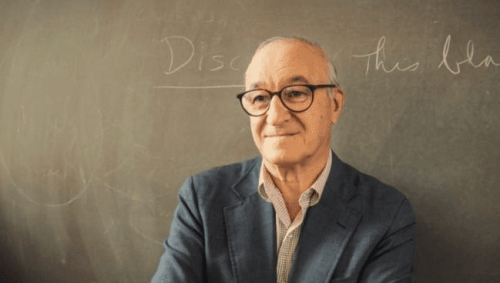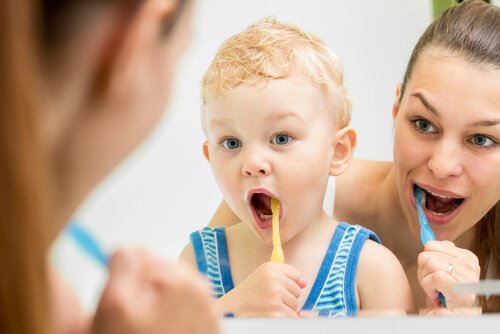Albert Bandura's Social Learning

We know Albert Bandura for being the father of social learning and one of the most influential psychologists of all time. He was so influential that this past year the White House awarded him a medal at an event.
At a time when behaviorism dominated the psychology of learning, Bandura went a step further and formulated his social learning theory. From then on, the cognitive and social processes that mediated people’s learning begin to have importance. Their importance wasn’t just related to the associations between stimuli or the reinforcements that follow behaviors as behaviorism had done up to that point.
“The person is no longer a puppet at the expense of environmental contingencies. Rather, they’re able to put their private processes into play, such as attention or thinking, in order to learn.”
-Albert Bandura-
Nevertheless, Bandura recognized the role of conditioning in our environment and he became aware that it’s an important part of learning. However, he recognized that it’s not the only important part. In Bandura’s opinion, reinforcement is only necessary for execution to take place, not the learning itself.
We have to take into account our internal world when we incorporate a new behavior into our database or carry out behaviors that we already have but previously weren’t able to execute. Many of our current behaviors are due to imitation or vicarious learning of models that aren’t exactly relevant to us.
“Who hasn’t learned to make the same gestures as one of their parents when they have a conversation or to overcome some fear when they have seen that their best friend is capable of doing it?”
-Albert Bandura-

The importance of social learning
According to Bandura, there are three components that interact in a mutual way as far as learning is concerned. This is called reciprocal determinism or triadic reciprocity. These three components are the person, the environment, and the behavior. Therefore, the environment influences the subject and their behavior. The subject also influences the environment through their behavior as well as the behavior of the subject themselves.
People learn by observing others, the people in their environment. They don’t only learn by reinforcements or punishments as behaviorists say. Merely observing others produces certain learning effects in our brains without the need for direct reinforcement or punishment.
We can observe these effects in Bandura’s famous Bobo doll experiment. Bandura conducted the experiment with children between the ages of three and five years. He then separated them into two groups. One of them was shown an aggressive model and the other a non-aggressive model. Each group observed a room with toys and a corresponding model. The children who saw the aggressive behavior were more likely to be aggressive with the doll. The children who didn’t see the aggressive behavior were less likely to be aggressive with the doll.
This research allows us to understand why some people behave the way they do. For example, the challenging behaviors of some teenagers born into unstructured families and who have seen certain negative behaviors may have a reason for acting that way. Their environment has taught them to imitate their reference models and they have incorporated those actions into who they are.
What influences vicarious learning?
According to Bandura, in addition to the three basic elements mentioned above, there are a series of processes that are necessary for learning to occur through observation:
- Attention. Attention is fundamental. In this process, variables such as the intensity of the stimulus, relevance, size, novelty or frequency can all have an influence. The important variables have to do with the performing model. These include sex, race, age, and importance granted by the observer. These can all modify the attention process. Regarding the situation’s variables, researchers have seen that the most difficult tasks can’t be copied while the easiest ones lose attention.
- Retention/memory. This is a process closely related to memory. It allows the subject to perform the behavior even if the model is no longer present. The association of the perceived with previously known elements, plus the cognitive practice or review of what has been learned, can help maintain the retentive capacity.
- Initiation/motor. This is the passage from the knowledge of images, symbols, or abstract rules to concrete and observable behaviors. For this to happen, the subject must have the basic skills to carry out the behavior. They must already have the behavior’s basic components within their repertoire of behaviors.
- Motivation. This is another important process for the execution of the learned behavior. The functional value of the behavior can cause someone to execute it or not. The value depends on direct, vicarious, self-produced, or intrinsic incentives.

What effects does observational learning have?
There are three different types of effects that can occur when observing the behavior of a model. They’re the acquisition effect, the inhibitory or disinhibitory effect, and facilitation.
- Effect of acquisition of new behaviors. The subject acquires new skills and behaviors thanks to imitation and necessary rules to complete them. They also develop new ones in the same line of action. Acquired behaviors aren’t only motor skills but emotional responses as well.
- Inhibitory and disinhibitory effect. If the previous effect generated the acquisition of new behaviors, it promotes the disinhibition or inhibition of existing ones by means of motivational changes. In this variable, the perception of the subject’s own capacity comes into play.
- Facilitation effect. Finally, this effect refers to the ease that observational learning provides to carry out existing behaviors that aren’t inhibited.
We have acquired many of our behaviors through imitation. Although it’s true that genetics plays an important role in how we act, the models and environment that surrounds us impact us even more. The trait of being shy, talking more slowly or more quickly, our gestures, our aggressiveness, having some type of phobia, are all, in part, learned through modeling.
Bandura’s social learning theory hasn’t only helped understand why people behave in a certain way. It also addresses those behaviors considered to be maladaptive by observing new models.
We know Albert Bandura for being the father of social learning and one of the most influential psychologists of all time. He was so influential that this past year the White House awarded him a medal at an event.
At a time when behaviorism dominated the psychology of learning, Bandura went a step further and formulated his social learning theory. From then on, the cognitive and social processes that mediated people’s learning begin to have importance. Their importance wasn’t just related to the associations between stimuli or the reinforcements that follow behaviors as behaviorism had done up to that point.
“The person is no longer a puppet at the expense of environmental contingencies. Rather, they’re able to put their private processes into play, such as attention or thinking, in order to learn.”
-Albert Bandura-
Nevertheless, Bandura recognized the role of conditioning in our environment and he became aware that it’s an important part of learning. However, he recognized that it’s not the only important part. In Bandura’s opinion, reinforcement is only necessary for execution to take place, not the learning itself.
We have to take into account our internal world when we incorporate a new behavior into our database or carry out behaviors that we already have but previously weren’t able to execute. Many of our current behaviors are due to imitation or vicarious learning of models that aren’t exactly relevant to us.
“Who hasn’t learned to make the same gestures as one of their parents when they have a conversation or to overcome some fear when they have seen that their best friend is capable of doing it?”
-Albert Bandura-

The importance of social learning
According to Bandura, there are three components that interact in a mutual way as far as learning is concerned. This is called reciprocal determinism or triadic reciprocity. These three components are the person, the environment, and the behavior. Therefore, the environment influences the subject and their behavior. The subject also influences the environment through their behavior as well as the behavior of the subject themselves.
People learn by observing others, the people in their environment. They don’t only learn by reinforcements or punishments as behaviorists say. Merely observing others produces certain learning effects in our brains without the need for direct reinforcement or punishment.
We can observe these effects in Bandura’s famous Bobo doll experiment. Bandura conducted the experiment with children between the ages of three and five years. He then separated them into two groups. One of them was shown an aggressive model and the other a non-aggressive model. Each group observed a room with toys and a corresponding model. The children who saw the aggressive behavior were more likely to be aggressive with the doll. The children who didn’t see the aggressive behavior were less likely to be aggressive with the doll.
This research allows us to understand why some people behave the way they do. For example, the challenging behaviors of some teenagers born into unstructured families and who have seen certain negative behaviors may have a reason for acting that way. Their environment has taught them to imitate their reference models and they have incorporated those actions into who they are.
What influences vicarious learning?
According to Bandura, in addition to the three basic elements mentioned above, there are a series of processes that are necessary for learning to occur through observation:
- Attention. Attention is fundamental. In this process, variables such as the intensity of the stimulus, relevance, size, novelty or frequency can all have an influence. The important variables have to do with the performing model. These include sex, race, age, and importance granted by the observer. These can all modify the attention process. Regarding the situation’s variables, researchers have seen that the most difficult tasks can’t be copied while the easiest ones lose attention.
- Retention/memory. This is a process closely related to memory. It allows the subject to perform the behavior even if the model is no longer present. The association of the perceived with previously known elements, plus the cognitive practice or review of what has been learned, can help maintain the retentive capacity.
- Initiation/motor. This is the passage from the knowledge of images, symbols, or abstract rules to concrete and observable behaviors. For this to happen, the subject must have the basic skills to carry out the behavior. They must already have the behavior’s basic components within their repertoire of behaviors.
- Motivation. This is another important process for the execution of the learned behavior. The functional value of the behavior can cause someone to execute it or not. The value depends on direct, vicarious, self-produced, or intrinsic incentives.

What effects does observational learning have?
There are three different types of effects that can occur when observing the behavior of a model. They’re the acquisition effect, the inhibitory or disinhibitory effect, and facilitation.
- Effect of acquisition of new behaviors. The subject acquires new skills and behaviors thanks to imitation and necessary rules to complete them. They also develop new ones in the same line of action. Acquired behaviors aren’t only motor skills but emotional responses as well.
- Inhibitory and disinhibitory effect. If the previous effect generated the acquisition of new behaviors, it promotes the disinhibition or inhibition of existing ones by means of motivational changes. In this variable, the perception of the subject’s own capacity comes into play.
- Facilitation effect. Finally, this effect refers to the ease that observational learning provides to carry out existing behaviors that aren’t inhibited.
We have acquired many of our behaviors through imitation. Although it’s true that genetics plays an important role in how we act, the models and environment that surrounds us impact us even more. The trait of being shy, talking more slowly or more quickly, our gestures, our aggressiveness, having some type of phobia, are all, in part, learned through modeling.
Bandura’s social learning theory hasn’t only helped understand why people behave in a certain way. It also addresses those behaviors considered to be maladaptive by observing new models.
This text is provided for informational purposes only and does not replace consultation with a professional. If in doubt, consult your specialist.







